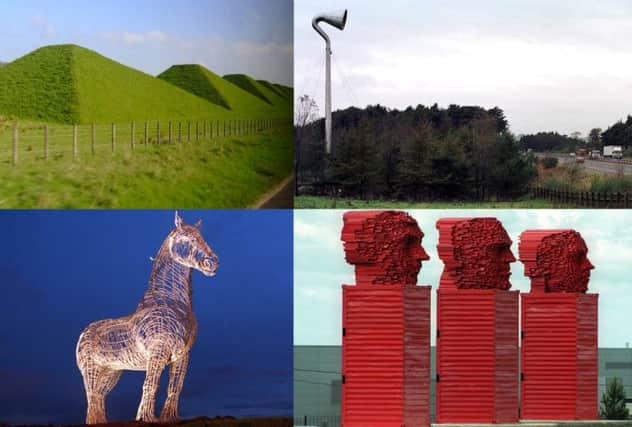Scottish fact of the day: M8 motorway sculptures


Construction on the 60-mile long road was completed in 1965, designed to replace the A8 as an alternative for intercity travel.
In 191, a group was set up with the intention of creating an ‘art corridor’ on the motorway, designed to brighten the route up and turn it into a talking point.
Advertisement
Hide AdDubbed the M8 Art Project, the scheme was the first ever substantial commitment to environmental motorway public art in Britain and sealed Scotland’s place as the European leader in the field.
The Scottish Office supported the project in the early Nineties and had already been involved in environmental improvements to the tune of £700,000 comprising newly-planted trees and landscaping.
One provision of the project was that artworks would have to be clearly visible and allow drivers and passengers to see them without causing alarm or risking a safety hazard.
But what of the sculptures that ended up alongside the motorway?
Sawtooth Ramps, Patricia Leighton, 1993
The first sculpture to be completed was the Sawtooth Ramps, completed in 1993.
Overlooking the M8 near Bathgate and Blackburn in West Lothian, it was constructed from earth and seeded with grass.
Advertisement
Hide AdCommissioned by Motorola, for the edge of their Easter Inch mobile phone manufacturing plant (1992-2001), the sculpture was created by New York artist Patricia Leighton.
Measuring 1000ft-long and consisting of seven 36ft-high ramps, the sculpture was based on local geographic features such as drumlins and the shape of the nearby shale bings.
Advertisement
Hide AdSheep were eventually allowed to graze on the sculpture, keeping the grass short and adhering to the environmental aspect of it.
The pyramid shape of the ramps provided a name for the nearby Pyramids Business Park and in April 2007, a local farmer dyed the sheep red using a harmless sheep spray.
Giant poppies are often painted on the Sawtooth Ramps for Remembrance Day.
Heavy Horse, Andy Scott, 1997
Situated in the Glasgow Business Park is the second of our sculptures - the Heavy Horse.
Designed and crafted from galvanised steel by Andy Scott (who also created the famous Kelpies sculpture), the Heavy Horse is a wirework sculpture of a Clydesdale, and has become the symbol of the Baillieston business park.
Standing 14¾ft tall, the horse inspired the name for the business park’s newest office building - Clydesdale House.
Advertisement
Hide AdThe Clydesdale breed of horse is native to Scotland and was founded in Lanarkshire - formerly called Clydesdale.
The Horn, Matthew Dalziel / Louise Scullion, 1997
Perhaps the most noticeable of all the sculptures is The Horn, located in Polkemmet Country Park in West Lothian.
Advertisement
Hide AdThe idea behind the 79ft-high stainless steel sculpture, which overlooks the motorway between Whitburn and Harthill, was to communicate with passing vehicles.
Commissioned by West Lothian Council and designed by Dundee artists Matthew Dalziel and Louise Scullion, The Horn broadcasts music, poetry and famous quotes at traffic on the west-bound carriageway in windy weather.
It was inaugurated in November 1997 by the chairman of the Scottish Arts Council, Magnus Linklater.
Big Heids, David Mach ,1999
Finished in 1999 and the last of the four, David Mach’s Big Heids sculpture is situated on the south side of the A8 trunk road, on the edge of the Eurocentral industrial and distribution base, just north of Holytown.
The Big Heids sculpture is made up of three giant heads, each 33ft high and weighing 18 tons.
Stood on upturned freight containers themselves measuring 23ft high, the heads are a tribute to Lanarkshire’s steel industry, being made of welded steel tubes similar to those once made at the former Clydesdale Steel Works at Mossend.
Advertisement
Hide AdThe project itself gained prominence as an engineering training programme involving apprentices and adult trainees.
Costing £273,000, the three heads are modelled on the faces of local volunteers chosen at random from the streets of Motherwell, with construction taken on by engineering company Motherwell Bridge.
They were reportedly dubbed Clara, Gerry and Brian by the teams building them, although it’s unclear if these were the names of the Motherwell locals.